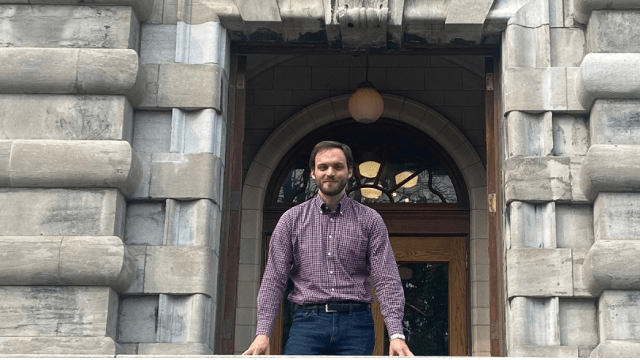After completing his training in the mechanical department at ENS Paris-Saclay and obtaining his Ph.D. at Polytechnique, Filippo Agnelli moved to Montreal, specifically to McGill, for a two-year postdoc.
What is your research topic ?
I have been at McGill for a year in Professor Pasini's team. In collaboration with Autodesk, I am working on the development of generative design algorithms aimed at bringing new features to CAD (Computer-Aided Design) and CAM (Computer-Aided Manufacturing) software. Generative design is a procedure using Artificial Intelligence (AI) to automatically draw the shapes and contours of structural objects based on information obtained from numerical simulations reflecting the specifications of the problem. Ultimately, I believe these new methods will streamline structural design and foster innovation in various mechanical domains by reducing iterations between teams during prototype development.
How did you end up in Montreal?
From the third year of my Ph.D., I started pondering about what I wanted to achieve at the end of my doctorate. Initially, I was inspired by reading the book 'De l'autre côté du miroir' by Aurélie Jean, who is also a mechanical engineer and an alumna of ENS Paris-Saclay. Her journey depicted in the book greatly inspired me and motivated me to pursue a postdoc, seeking opportunities on a different continent, particularly in North America. While researching mechanical laboratories aligning with my profile, I came across Professor Pasini's research team at McGill University. We established contact, leading to an interview, and at the time of determining the project for the postdoc, McGill and Autodesk had just initiated a collaboration, fitting perfectly with the requirements of my profile.
Your contract is for two years. Do you think you will have significant results so quickly?
On the topic we are studying, achieving a definitive answer in two years is inconceivable. However, we hope to provide preliminary results that will advance research and continue the project in the long term. At this point, I see myself continuing this research even after this postdoc. There may be other collaboration opportunities here or across the Atlantic. Autodesk is a multinational company with 12,000 employees and collaborations worldwide. Currently, I work with colleagues in England, the United States, Singapore... as it is a project primarily computer-based, allowing for flexibility. Today I am in Montreal, but tomorrow I may not necessarily have constraints to stay in Canada to continue.
How is research in Quebec at an English-speaking university?
The language barrier was not an issue for me. I was already accustomed to conducting research in English during my Ph.D. However, a significant change is how research is managed in North America or at least at McGill. In France, academic research revolves around the laboratory, bringing together professors with their teams. This allows sharing tools and resources within the laboratory and fosters collaborations between professors within the same unit. In North America, the organization is centered around the principal investigator professor. I found it more challenging to exchange or collaborate with other research teams.
Is life enjoyable in Montreal?
The city of Montreal objectively offers an exceptional living environment despite the harsh winter climate. It is a very stimulating city with numerous work and life opportunities. Perhaps, to qualify my statement, one must be prepared to go through administrative procedures to come here. The work permit application is not straightforward, or at least it was not for me. Keep in mind that changing continents is a burden that is later rewarded by the experiences here, but you must be ready to take that step.
Have you met any alumni from ENS or Polytechnique here?
Before arriving, I knew that two of my fellow alumni from the same year were here. I also knew about a former Ph.D. student from my laboratory at Polytechnique who came to Montreal for a postdoc before me. Coming out of the pandemic, it was reassuring to know someone before arriving on a new continent. It influenced my decision to come to Montreal.
What do you think of the idea of developing the network of ENS Paris-Saclay alumni?
I think it's a good idea. It's good to maintain a connection among alumni, and I believe it can help build new careers outside the beaten paths, like Aurélie Jean's, for example. I could get involved in structuring a normalien network, organizing in-person or virtual events. I have no experience in the subject, but in other areas, I have participated in networking events.
What memory do you have of ENS Paris-Saclay?
I have good memories of ENS. What the school provided me was, first and foremost, excellent training as a mechanical engineering researcher, and then, thanks to the professors, a passion for research in the field of structural mechanics and materials. It wasn't necessarily what I had imagined before coming to the school because I was truly passionate about the transportation sector, especially the railway sector. However, upon arriving at ENS, and especially during the Magis Master 2 (Mechanics of Materials for Engineering and Structural Integrity), I was truly touched by the efforts and passion of the teachers. It really fueled my desire to pursue a Ph.D. and then a career as a researcher in this sector.
Where do you see yourself in 10 years?
I will be conducting research in a field that interests me and where I can see an application within 5 to 10 years. I don't want to work on something too abstract. I am very curious, and I always need to satisfy this curiosity by understanding new concepts and ideas.

Comments0
Please log in to see or add a comment
Suggested Articles


